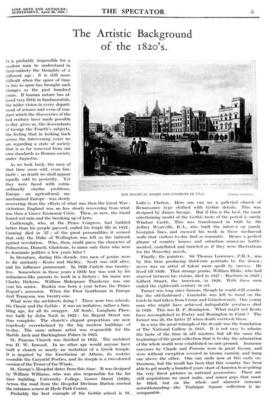The Artistic Background of the 1820's.
IT is probably impossible for a modern man to understand in their entirety the thoughts of a different age ; it is still more difficult when the space of time he has to span has brought such changes as the past hundred years. If human nature has al- tered very little in fundamentals. the wider vision in every depart- ment of science and even of con- duct which the discoveries of the last century have made possible to-day gives us, the descendants of George the Fourth's subjects, the feeling that in looking back across the intervening years we are regarding a state of society that is as far removed from our own standards as Roman society under Augustus.
Castlereagh, who, at the Peace Congress, had builded better than his people guessed, ended his tragic life in 1822 ; Canning died in '27 ; of the great personalities it seemed that only the Duke of Wellington was left as the bulwark against revolution. Who, then, could guess the character of Palmerston,•Disraeli, Gladstone, to name only three who were to dominate politics a few years later ?
In literature, during this decade, two men of genius were to die untimely—Keats and Shelley. Scott was still alive, and his influence paramount. In 1820 Carlyle was twenty- five. Somewhere in these years a little boy was sent by his unbusiness-like parents to work in a factory ; his name was Charles Dickens. William Makepeace Thackeray was one year his senior. Ruskin was born a year before the Prince Regent's accession. When the First Gentleman in Europe died Tennyson was twenty-one.
What were the architects doing ? There were two schools, the Classic and the Gothic : it was an imitative, rather a fum- bling age, for all its swagger. All Souls', Langham Place, was built by John Nash in 1822: his Regent Street was thus complete. The church's elegant proportions are now hopelessly overwhelmed by the big modern buildings of to-day. The same urbane artist was responsible for the Marble Arch and Buckingham Palace in 1825.
St. Pancras Church was finished in 1822. The architect was H. W. Inwood. In no other age would anyone have built a church so nearly an imitation of a Greek temple. It is inspired by the Erectheion at Athens, its vestries resemble the Caryatid Portico, and its steeple is a two-storied version of the Tower of the Winds.
St. George's Hospital dates from this time. It was designed by William Williams, who was also responsible for the far finer building, University College, Gower Street (1828). Across the road from the Hospital Decimus Burton erected the entrance screen at Hyde Park Corner.
Probably the best example of the Gothic school is St.
THE DOUSE OF LORDS AND COMMONS IN 1821.
L Parker Gallerse,
Luke's, Chelsea. Here one can see a galleried church of Renaissance type clothed with Gothic details. This was designed by James Savage. But if this is the best, the most entertaining model of the Gothic taste of the period is surely Windsor Castle. This was transformed in 1826 by Sir Jeffrey Wyatville, R.A., who built the interior on purely Georgian lines, and encased his work in those mediaeval walls that visitors to-day find so romantic. Hence a perfect plague of country houses and suburban mansions battle- mented, castellated and turreted as if they were illustrations for the Waverley novels.
Finally, the painters. Sir Thomas Lawrence, P.II.A., was by this time producing third-rate portraits by the dozen ; never was an artist of talent more spoilt by success. He lived till 1830. That strange genius, William Blake, who had starved between his visions, died in 1827 ; Raeburn in 1823 ; Gilbert Stuart, the American, in 1828. With these men ended the eighteenth century in art.
Turner was long since famous, though he could still scanda- lize the old-fashioned ; Constable was left to hand on the torch he had taken from Crome and Gainsborough. One young man who might have achieved indisputable greatness died in 1828. This was R. P. Bonington. What might not Keats have accomplished in Poetry and Bonington in Paint ? The former was 26, the latter 27 when death overtook them.
In a way the great triumph of the decade was the foundation of The National Gallery in 1824. It is not easy to admire the taste of the time in old masters, but all the same the beginnings of the great collection that is to-day the admiration of the whole world were established on sure ground. Immense canvases by Claude and Poussin were in great favour, and were without exception covered in brown varnish, and hung one above the other. One can smile now at this early en- thusiasm, but the result has been that this country has been able to get nearly a hundred years' start of America in acquiring the very finest pictures as national possessions. There are still acquisitions we must make, and minor gaps that must be filled, but on the whole—and alarmist rumours notwithstanding—the Trafalgar Square collection is in- comparable.
























































 Previous page
Previous page